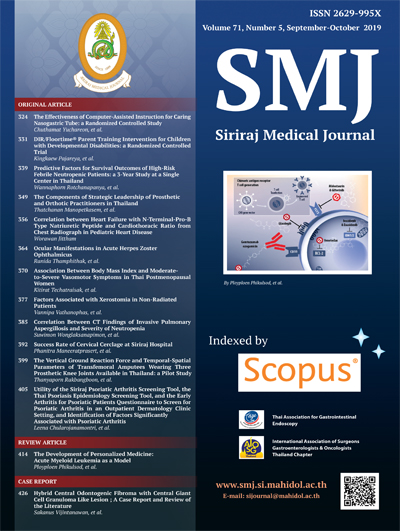The Components of Strategic Leadership of Prosthetic and Orthotic Practitioners in Thailand
DOI:
https://doi.org/10.33192/Smj.2019.53Keywords:
Strategic leadership; prosthetic and orthotic practitionersAbstract
Objective: To determine the components and to test the validity of factor analysis of strategic leadership among prosthetic and orthotic practitioners in Thailand with the empirical data.
Methods: The sample consisted of 754 prosthetic and orthotic practitioners from 200 government hospitals in Thailand. The two instruments used were structured interview and questionnaires consisting of 66 items with Item-Objective Congruence (IOC) at 0.96 and the reliability of questionnaire in the form of Cronbach alpha coefficient was 0.98. The content analysis, exploratory factor analysis and confirmatory factor analysis were used to analyze data.
Results: There were 7 components of strategic leadership among prosthetic and orthotic practitioners in Thailand which consisted of 42 factors with factor loadings as follows: relating the part to the whole (0.997), corporate spirit (0.904), strategic thinking and planning (0.899), building partnerships (0.896), developing today’ and tomorrow’s leader (0.878), making it happen (0.865), and giving direction (0.823). The validity test results of factor analysis of strategic leadership among prosthetic and orthotic practitioners in Thailand were confirmed with the empirical data.
Conclusion: From the research findings, 7 components of strategic leadership should be developed among prosthetic and orthotic practitioners, particulary the first three components i.e., relating the part to the whole, corporate spirit, and strategic thinking and planning.
Downloads
Published
How to Cite
Issue
Section
License
Authors who publish with this journal agree to the following conditions:
Copyright Transfer
In submitting a manuscript, the authors acknowledge that the work will become the copyrighted property of Siriraj Medical Journal upon publication.
License
Articles are licensed under a Creative Commons Attribution-NonCommercial-NoDerivatives 4.0 International License (CC BY-NC-ND 4.0). This license allows for the sharing of the work for non-commercial purposes with proper attribution to the authors and the journal. However, it does not permit modifications or the creation of derivative works.
Sharing and Access
Authors are encouraged to share their article on their personal or institutional websites and through other non-commercial platforms. Doing so can increase readership and citations.















